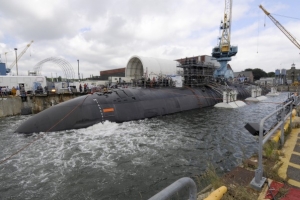Portsmouth Naval Shipyard

The Portsmouth Naval Shipyard, despite its name, is actually located across the Piscataqua River in Kittery, Maine. However, as a major area employer and economic force, policies at the naval yard continue to have a significant impact in New Hampshire.
The shipyard currently employs roughly 6,100 civilian workers. An additional 100 or so military personnel are stationed there. The facility covers over 297 acres including the base and associated family housing. The yard itself is situated on Seavey's Island.
Portsmouth currently serves as one of the U.S. Navy’s leading facilities for modernizing, overhauling, and decommissioning nuclear submarines.
History
The Portsmouth Naval Shipyard is the oldest continuously-operating yard in the U.S. Navy with a history that goes back to the early colonial era, when the Piscataqua area was the site of shipbuilding for both commercial purposes and for the British navy.
Perhaps the most famous craft to be built at Portsmouth is the Raleigh, a Revolutionary War-era vessel that was the first ship to fly the American flag. The Raleigh is depicted on New Hampshire’s state seal.
The yard was made an official U.S. naval facility in the early 1800s during the John Adams administration.
During World War I, the facility’s focus shifted to submarine construction. In 1969, the shipyard underwent a further change to focus on overhauling and modernizing existing submarines.
At its peak during World War II, the shipyard employed nearly 25,000 civilians.
Tax and economic impact
A 2016 report found that the shipyard contributed nearly $733 million to the economies of Maine and New Hampshire. $274.2 million of that total was made up of civilian payroll to Maine residents, with $173 million going to New Hampshire-based workers. The additional funds were spent on contracted services and purchased goods.
As the shipyard is located in Maine, all employees are subject to Maine income tax, even if they reside in New Hampshire. Maine income tax is applied to household income, which means that the spouses of shipyard workers are also effectively taxed, even if they live and work in the Granite State.
It’s estimated that Maine earns roughly $5.5 million annually from New Hampshire residents who work at the yard.
Border dispute
Seavey’s Island, on which the Portsmouth Naval Shipyard sits, was the subject of a fierce border dispute between New Hampshire and Maine.
The battle to claim jurisdiction over the site flared up in the 1990s, pushed by shipyard workers who lived in New Hampshire but, thanks to Maine tax policy, were required to pay Maine income tax on their earnings.
New Hampshire filed suit over the issue with the U.S. Supreme Court in 2001, claiming new historic evidence had come to light that proved that the border between New Hampshire and Maine should be drawn along the north bank of the Piscataqua, thereby including Seavey’s Island.
The case was ultimately dismissed, the court citing New Hampshire’s previous agreement to a 1977 ruling over lobster fishing rights that saw the border defined along the middle of the river.
Risk of closure
In 2005, the Portsmouth Naval Shipyard was included on the list of facilities targeted for closure by the Base Realignment and Closure Committee (BRAC). The yard had survived a round of base closures in the 1960s as well as four previous BRAC rounds.
The base was ultimately removed from the 2005 BRAC list after employees organized a “Save Our Shipyard” campaign that garnered key bipartisan support from both New Hampshire and Maine governors, congressional delegations, and local politicians.
Following the 2005 BRAC process, commissioners recommended that Congress authorize another BRAC round in 2015 and every eight years thereafter. However, the 2015 BRAC round was shot down by the U.S. House Armed Services Committee, citing concerns over the high costs of the process.
U.S. Defense Department officials continue to press for another round of base closures, citing an estimated 22% excess in capacity across all branches of the armed services. This excess, however, is believed to be much lower for U.S. Navy facilities, at around only 7%.
No alternative process to BRAC for authorizing the closure of naval and other military bases has been approved as of yet.
"The Portsmouth Naval Shipyard should stay open."
- The shipyard is an important employer for both Maine and New Hampshire.
- It’s estimated that the yard contributes roughly $733 million to the economies of southern Maine and the New Hampshire seacoast through contracts, wages and purchase of services.
- The shipyard is reported to be one of the Navy’s most efficient bases and therefore represents a sound investment for federal defense dollars.
- The BRAC process is inherently political and the recommended closures do not necessarily reflect issues of cost-effectiveness, quality, and efficiency.
"The Portsmouth Naval Shipyard should be closed."
- The 2005 BRAC committee reported that it would be possible to relocate Portsmouth’s work to other naval bases such as those in Norfolk, VA; Pearl Harbor, HI; and Puget Sound, WA.
- Closing Portsmouth and moving its submarine work to Norfolk would still maintain a facility on the Atlantic.
- BRAC estimated transferring Portsmouth’s work to other bases would save a net 2,400 jobs and roughly $1.3 billion after 20 years.
- Portsmouth has been argued to have a low military value in comparison to other bases with similar functions.











Comments
Login or register to post comments